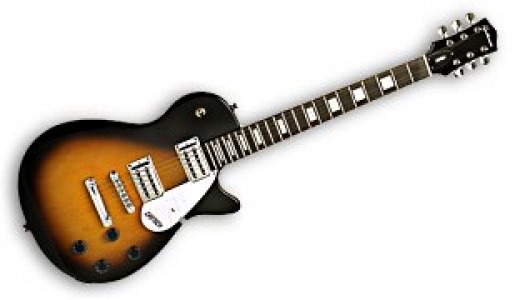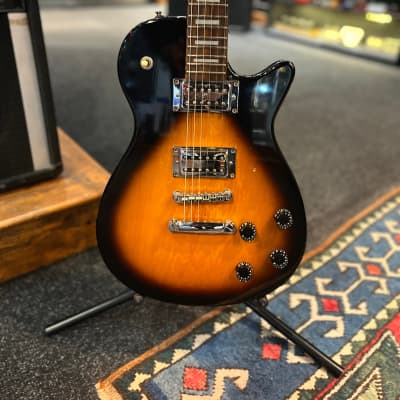Overview
Brand name:
Product:
- electric guitars
Series name:
Dates of manufacture:
The Gretsch Jet Club G1413 was an electric guitar in the Korean-made Electromatic line from Gretsch. It sold between 2000 and 2003. The Electromatic brand was applied to a series of less-expensive solids and semis based on classic Gretsch designs, priced to compete with Epiphone and similar budget brands.
The small-bodied solid Jet Club has the classic 1950s Gretsch single-cutaway shape: an interpretation of the Les Paul body style. The Jet Club's angled back headstock uses the slim Gretsch outline with the central hump top and tuners are standard large button contemporary types in chrome. Early examples had a 'by Gretsch' suffix under the Electromatic brand logo on the face, but this has now gone missing, leaving the truss-rod cover to confirm the company connections up top.
The nut slots are cut for minimal first fret clearance and their spacing leaves plenty of room between E strings and edges of the fingerboard. The latter is an unbound smoothish length of rosewood with slim to medium frets. These are partnered by block position markers and the white side repeater dots could be brighter for better reference. The all-black gloss finish on the neck blends well with the body colour scheme and also hides the scarf joint for the headstock. The neck has a comfortable C-profile. The Jet Club has a four-screw neck fixing method, a departure from Gretsch tradition which isn't overtly obvious from the front.
Although the Jet Club superficially resembles a Les Paul, the curves of this single-cutaway body are broader and more squat, the same as those devised by Gretsch back in the 50s as this maker's answer to Gibson's then new solid six-string. The lack of body contouring or carving creates a slabby, Les Paul Junior-like image, further reinforced by the lack of binding and the shading of the high-gloss tobacco sunburst finish with black back and sides. Although the manufacturer’s specification states that the body is alder, inspection of the control cavity reveals multi-laminated construction, confirmed by some faint rippling apparent in the finish on the sides.
The pearloid pickguard is cut to the classic Gretsch 50s shape and bears the company logo, as do the chromed cover pickups, which have vaguely FilterTron styling and contribute to the vintage Gretsch vibe. Their metal surrounds are equally shiny, while the Gibson design-derived bridge and bar tailpiece. The control layout is equally pure Les Paul in terms of components and their respective locations.
Lars Mullen reviewed the Jet Club for Music Mart Magazine on its introduction in 2000:
Acoustically the Jet Club sounds quite thin and nasal, but plugging in reveals that the pickups more than compensate for any inherent lack of low end. These are pretty powerful brutes that shove out a fair old signal well endowed with warmth and muscle. The neck humbucker has bags of bottom and a woody mid-range, while treble response is smooth rather than shouting.
This ability is something best left to the bridge pickup which sharpens up a very similar act courtesy of some cutting attack, although this is far from hard or harsh, instead relying on a hammerlike smack to make its presence felt. The humbuckers' combined might introduces a honky quality but is still endowed with a dark-toned edge. The sounds work best with enough gain added to roughen things up for a bit of raunch, but dial in much more distortion and things become a mite too mushy for aural comfort, with definition, expression and attack suffering accordingly.
The Jet Club offers a low-cost interpretation of classic Gretsch design, combined with Gibson-derived features, and the end result is one of the more characterful contenders in the low-cost pseudo Les Paul market. The bolt-on neck and unadorned slab body make no bones about this Electromatic's back-to-basics approach, but such simplicity has its own appeal and the Jet Club offers a good balance of all the important aspects. Playability is very good and performance is certainly up to par, relevant to price range. Overall abilities make the Jet Club one to consider in a very competitive sector of the market.
References
Music Mart Magazine, September 2000
Blue Book of electric guitars 2006
Specifications
Prices (8)
| Date | Price | Condition | Name | Comments |
|---|---|---|---|---|
| 2016 | $55 | worn | ||
| 2000 | $150 | excellent | ||
| 2000 | $275 | new | ||
| 2010 | $250 | good | ||
| 2017 | R$1200 | good | ||
| 2018 | R$3000 | good | ||
| 2018 | $480 | excellent | ||
| 2015 | $275.00 | excellent | hot pickup, good value |



